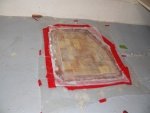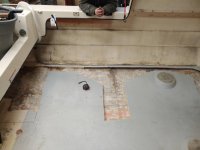Marco Flamingo
Active member
- Joined
- Jul 9, 2015
- Messages
- 1,170
- Reaction score
- 0
- C Dory Year
- 2004
- C Dory Model
- 16 Cruiser
- Vessel Name
- Limpet
Bob's post mentions release fabric or Peel Ply. It appears to be regular nylon "parachute cloth" type of fabric, but maybe it is something special. Any store with fiberglass fabric should carry it. It can be used to smooth out the surface of the repair, whether mat or cloth (I'd recommend cloth for anything to do with the hull).
Surface smoothness is great, but it might not be the biggest benefit. If the Peel Ply doesn't leave as smooth of surface as you want, a second coat of pure epoxy should fix that. Because the Peel Ply rips off the surface of the epoxy, the amine blush is removed. If Peel Ply isn't used, you have to sand the surface to remove the amine blush and get another coat of epoxy to bond. I used it in my hull repair shown in my photo album under "Balsa Core Issues."
Anything that eliminates sanding during fiberglass repair is money well spent.
Mark

Surface smoothness is great, but it might not be the biggest benefit. If the Peel Ply doesn't leave as smooth of surface as you want, a second coat of pure epoxy should fix that. Because the Peel Ply rips off the surface of the epoxy, the amine blush is removed. If Peel Ply isn't used, you have to sand the surface to remove the amine blush and get another coat of epoxy to bond. I used it in my hull repair shown in my photo album under "Balsa Core Issues."
Anything that eliminates sanding during fiberglass repair is money well spent.
Mark


